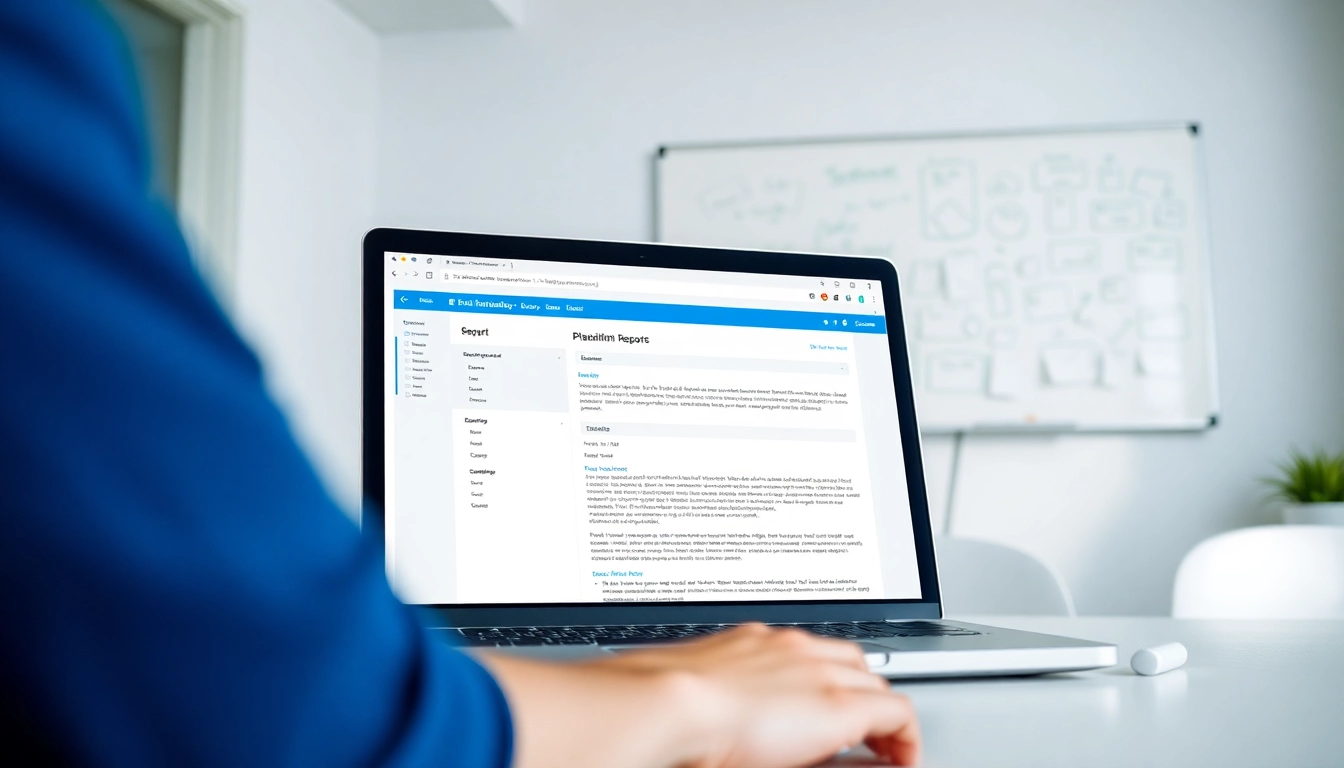Understanding Plagiarism: Definition and Consequences
What is Plagiarism?
Plagiarism can be defined as the act of using someone else’s work, ideas, or expressions without proper acknowledgment, effectively presenting them as one’s own. This can include texts, images, music, and even ideas. In academic and professional contexts, plagiarism not only undermines the original creator’s efforts but also disparages the integrity of the work of the plagiarist. It is crucial for students, researchers, and professionals to understand that plagiarism extends beyond mere copying; it encompasses a range of unethical practices, including paraphrasing without credit, self-plagiarism, and incorrect citation.
The Impact of Plagiarism in Academia
The ramifications of plagiarism in academia are far-reaching. Educational institutions uphold stringent academic integrity policies; hence, students caught plagiarizing can face severe penalties such as failing grades, suspension, or expulsion. The impact extends to the faculty and institutions themselves, which may suffer reputational damage and loss of credibility. Additionally, original thought is compromised, leading to a stagnation of intellectual progress. To avoid these pitfalls, educational institutions are increasingly embracing tools such as a plagiarism detector to promote original work and ethical scholarship.
Legal and Ethical Implications of Plagiarism
From a legal standpoint, plagiarism can lead to copyright infringement, often resulting in lawsuits and financial penalties. Ethically, it poses challenges regarding trust and credibility within academic fields. The ethical implications also resonate in professional environments, where trust is a cornerstone of business relationships. Fostering a culture of originality, accountability, and respect for intellectual property is of paramount importance in both academic and professional settings.
How a Plagiarism Detector Works
Technology Behind Plagiarism Detection
Plagiarism detectors are sophisticated tools that employ various technologies to analyze submitted texts against vast databases of resources. At their core, these systems use algorithms to identify similarities between a user’s work and existing texts. Commonly, they rely on techniques such as fingerprinting, which breaks down text into smaller components, and string matching, which seeks out exact or near-exact strings of text. Advanced detectors also use contextual analysis, machine learning, and natural language processing to gauge deeper thematic similarities and detect paraphrasing.
Key Features to Look for in a Plagiarism Detector
When selecting a plagiarism detector, consider the following key features:
- Database Size: A larger database ensures a more comprehensive analysis of potential sources.
- Reporting Capabilities: Look for detailed reports that clearly indicate the percentage of similarity and highlight the plagiarized sections.
- File Compatibility: The ability to check various file formats, including PDFs, Word documents, and web content.
- Usability: An intuitive user interface can enhance the user experience, making it easy to navigate through functionalities.
- Real-Time Analysis: Instant results allow users to make immediate adjustments to their work.
Varied Algorithm Approaches and Their Efficacies
Different plagiarism detectors utilize varied algorithms, each with unique strengths. Some detectors mainly focus on direct text matching, while others implement advanced artificial intelligence techniques for spotting paraphrased content. Machine learning algorithms can enhance accuracy over time, learning from user interactions and improving detection capabilities. Understanding the efficacy of these algorithms can significantly impact the choice of a plagiarism detector as it can determine the tool’s effectiveness in meeting specific needs.
Comparison of Popular Plagiarism Detectors
Features of Top Online Plagiarism Detectors
Several popular plagiarism detectors stand out in the market due to their robust features. Services like Turnitin and Grammarly offer advanced checking mechanisms. Turnitin is well-regarded in academic circles for its extensive database and intricate similarity reports, while Grammarly is favored for its user-friendly interface and additional grammar-checking features. Tools like Duplichecker and Copyleaks provide free services, focusing on ease of use, though they may lack the depth of analysis that paid versions offer. Evaluating which features are non-negotiable for your needs is essential for making an informed decision.
Cost Analysis: Free vs. Paid Services
The difference between free and paid plagiarism detectors often revolves around database access and report quality. Free services can suffice for casual users or small texts, but they may not capture every instance of potential plagiarism. Paid services, on the other hand, typically provide more comprehensive results, greater accuracy, and enhanced security features. An investment in a reputable paid service can yield long-term benefits, especially for students or professionals reliant on high-quality work.
User Experience and Accessibility Factors
User experience is a critical consideration when evaluating a plagiarism detection tool. The accessibility of features such as customization options, ease of navigation, and responsive customer support can greatly influence overall satisfaction. Platforms that offer intuitive dashboards, straightforward uploading processes, and personalized support are often favored by users. Moreover, seamless accessibility via mobile devices enhances usability for on-the-go learners and professionals.
Best Practices for Using a Plagiarism Detector
How to Effectively Input Text for Detection
To achieve optimal results from a plagiarism detector, proper input of text is crucial. Users should ensure that documents are cleanly formatted, without extraneous elements that may confuse the detection process. Breaking down large texts into smaller segments can also improve accuracy, allowing the detector to perform thorough analyses without being overwhelmed. Users are encouraged to paste content directly into the interface instead of uploading files when possible, as this can sometimes allow for faster processing.
Interpreting Plagiarism Reports: A Step-by-Step Guide
Once the plagiarism detector has completed its analysis, interpreting the report is crucial for understanding the results. Most reports include a similarity percentage, indicating how much of the text matches other sources. Users should carefully review highlighted sections to distinguish between legitimate citations and potential plagiarism. Understanding citation styles and proper paraphrasing is essential for resolving reported matches. Learning to analyze these reports effectively helps in revising and improving the originality of the text.
Integrating the Detector into Your Writing Process
Incorporating a plagiarism detector into your writing process can significantly enhance originality. Writing drafts and revising with the detector in mind can prevent accidental plagiarism before submission. It is advisable to run the detector on various drafts to gauge improvements and make necessary adjustments. Additionally, using the detector during the research phase can help ensure that notes and potential ideas align with existing sources, fostering a stronger foundation for original work.
The Future of Plagiarism Detection Technology
Trends Shaping the Evolution of Plagiarism Detectors
As technology continues to evolve, plagiarism detectors are adapting to new challenges and environments. Trends such as the integration of AI and machine learning are creating more sophisticated detection strategies. Development of tools capable of assessing source integrity and originality checks for various forms of media (videos, images) is also on the rise. Furthermore, the emergence of blockchain technology could offer innovative solutions for verifying authorship and source originality in real-time.
AI and Machine Learning in Detecting Plagiarism
AI-powered plagiarism detectors employ machine learning algorithms that allow them to continuously learn from user input and improve over time. This capability leads to enhanced detection rates for complex plagiarism attempts, including nuanced paraphrasing and the integration of multiple sources. The use of AI also promotes personalized experiences, where systems can assist users in understanding their writing habits and suggest necessary changes to enhance originality.
Enhancing Academic Integrity Through Technological Advancements
Technological advancements play a pivotal role in bolstering academic integrity by making original work easier to ensure and validate. As plagiarism detection technology matures, it helps create a culture of accountability among students and professionals. Educators and institutions can leverage these advancements to foster honest academic practices while supporting students in their development of original thought. Ultimately, a commitment to integrating reliable technology into educational paradigms supports a brighter, more inventive future in scholarship.



